

Exploring our past to sort out myth from reality
Share this Page on
Facebook or Twitter

These are the voyages of the TimeShip Anachron.
Our Mission: To boldly explore the past, dispelling
mythinformation and mythconceptions
of American History along the way.
 Visit us on Facebook
Visit us on Facebook
Meet MythAmerica Series

Pt 1 Pt 2 Pt 3 Pt 4 Pt 5 Pt 6 Pt 7 Pt 8 Pt 9 Pt 10 Pt 11
The Not-So-Gay Nineties, Part 9
Columbian Kwakiutls
Have you ever seen a diorama depicting Native American (or Canadian First Nations) culture at a natural history museum, such as this Navaho group displayed for many years (it was “retired” in 2002) at the Smithsonian in Washington DC?
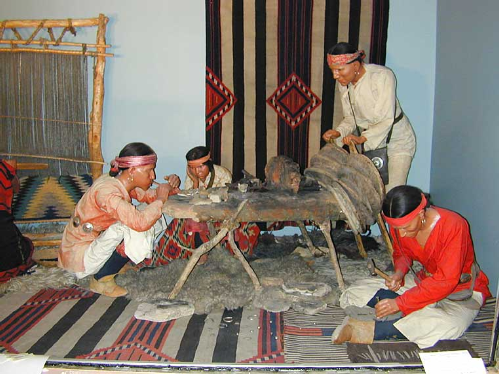
If so, you can thank the Chicago Columbian Exposition/World’s Fair of 1893 for one more of its legacies. Such life-
The obvious enthusiasm of the crowds for such displays made the gimmick catch on in the museum world. It was quickly imitated by museums across the country, including the Smithsonian, and remains popular to this day. It even shows up, of course, at places like Walt Disney World. For instance, in Epcot's Spaceship Earth, where you comfortably “ride by” a whole collection of such dioramas depicting other times and places.
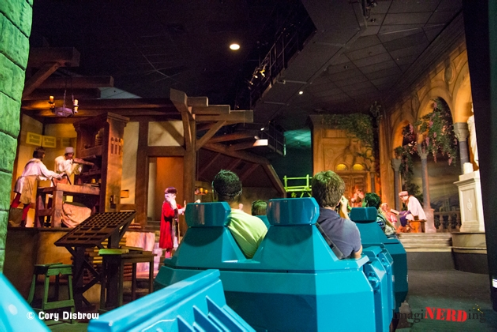
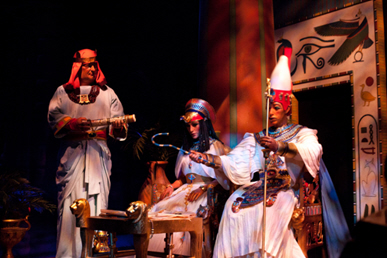
In addition to static dioramas, the Fair’s anthropology department also arranged for groups of “exotic peoples” from around the world to set up miniature “villages” and live in them on the grounds of the Exposition, giving fair-
A young German-
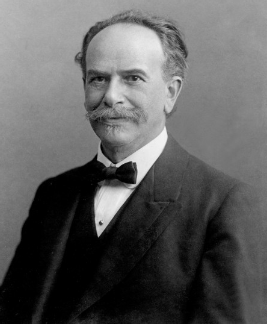
Boas was a hands-
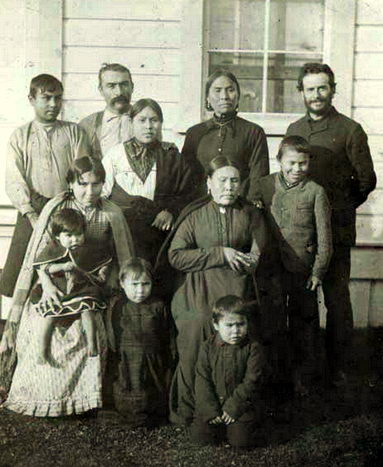 .
.
For the purposes of the Fair, he supervised the collection of many Kwakiutl artifacts, and even arranged for 13 adult and two young Kwakiutls to come to the Fairgrounds for six months to inhabit a “live exhibit” that was designed to look like a portion of an actual Kwakiutl village. In fact, a Kwakiutl building from their home area had been dismantled, shipped to Chicago, and rebuilt to look as it had in its original environment.
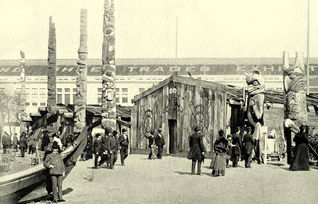
Examples of Kwakiutl totem poles flanked the building.
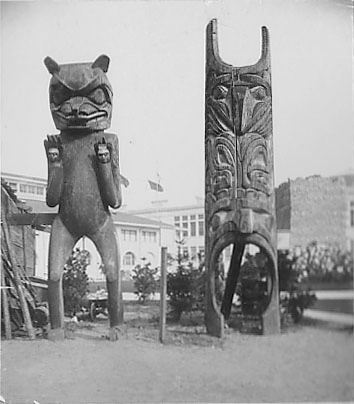
Although I think many modern folks tend to connect totem poles generically to just about any North American Indian tribes, they actually are an artifact almost totally limited to the tribes of the Pacific Northwest coast. Because of the influence of Franz Boas’s studies, the Kwakiutl totem pole is likely the most widely recognized. They have been carved primarily from the huge Western Red Cedars of the area, and because of the humid rainforest environment, they do not last indefinitely. There are very few poles left that were carved before 1900, as they have almost all decayed. Here is a 1909 photo of two “Thunderbird” poles in front of a Kwakiutl residence. These poles likely rotted away long ago.
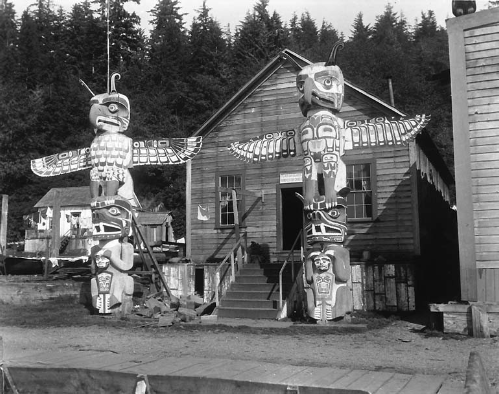
The art of carving the poles (and other traditional wooden ceremonial items such as masks) never died out totally, even as most of the natives adapted more and more to the “white man’s ways.” Today, resurgence among Kwakiutl of interest in maintaining their cultural heritage has encouraged the latest generation of native craftsmen to continue the preservation of the art of carving them. This pic below shows David Neel, descendant of famous Kawkiutl carvers going back several generations, with his sons helping him carve a modern totem pole.
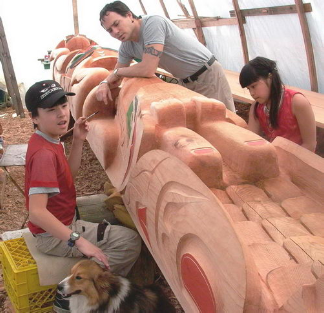
But back to the 1893 Kwakiutl exhibit at the Columbian Exposition.
It was right outside the main Anthropology building.
The Kwakiutl space was directly in front of the Leather and Shoe Trades Building, forcing Boas to hang white sheets behind the Indian performers to screen the Kwakiutl from their surroundings. This “framing” was emblematic of ambiguities that surfaced throughout the show, as native realities rubbed up against nationalist and racist expectations. These tensions are encapsulated in the example of the Samoan contingency, who took advantage of the lengthy cross-
You see, the overriding Darwinian “premise” of many of those men who organized the fair was that certain races were literally way back down the evolutionary trail from “Anglo-
One of the purposes for “exhibiting” them at the Fair was to reinforce the propriety of “Imperialism” as a necessary “way things ought to be.” White men needed to be in charge of the lands of such primitive people, because they were incapable of being in charge of their own affairs. The Fair organizers thus WANTED these peoples to all appear as primitive and ignorant as possible, not to be messing around with looking modern and getting “Americanized.” That would foul up the theory. Boas himself didn’t necessarily agree with that theory, by the way, but had his own reasons for wanting to keep the Kwakiutl stuck in their past.
Likewise, Boas’ Kwakiutl were performing rituals that at home were no longer practiced, and which had never been intended for the kind of display expected at the Exposition. Curtis Hinsley writes that “They were aiding Boas in his effort to recapture a presumed pristine, pre-
Yes, some of these authentic customs of the Kwakiutl…weren’t really Kwakiutl any more. Any more than most modern, affluent, white Americans attending the1893 Fair were spinning their own cotton, making their own fabrics, and sewing their own clothes back home.
In any event, there was a custom “performed” at the Fair that Boas later saw in person when visiting the Kwakiutl back in British Columbia on a later expedition. It was an initiation ceremony celebrated periodically by the mysterious Hamatsa secret society. The ceremonies of the Hamatsa particularly involved some of the gaudiest, most flamboyant carved wooden masks imaginable. You may have seen them if you’ve been to a Natural History Museum, as they are among the most popular museum artifacts of North American Native people.
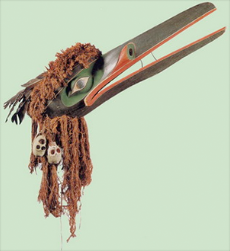
Among the most recognized masks of the Kwakwaka’wakw are the massive Hamatsa bird masks: Crooked Beak, Huk-
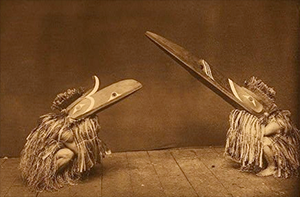
And here is their buddy, Crooked Beak.

The masks (actually, more like “headdresses,” as they envelope the head of the wearer) have “articulated mouths” that can be made to open and shut (either up and down, like a biting beak, or split down the front, in which case they open up like “doors” to show a different mask under the first one), and are used in ceremonial dances.
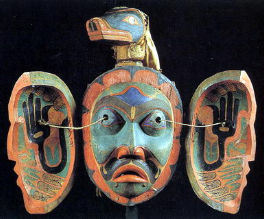
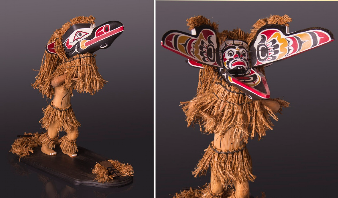
Members of the Hamatsa Dance Society dance these three masks during the initiation ceremony of new Hamatsa Society members. This particular ceremony dramatizes the struggle of good and evil forces for the young initiate’s soul. The giant Hamatsa birds are the earthly representatives of Baxwbakwalanuxwsiwe’, the colossal cannibal spirit in the sky world. The enormous birds try to lure the young person into the dark realm, while the family and tribe work tirelessly to liberate the forces of evil from the young person’s soul. When the initiation ceremony concludes (which can take several days), the forces of good, with any luck, have prevailed and the young initiate is ready to be a productive, positive contributing member to the Hamatsa society and the tribe. [Source]
Although this ceremony might only be performed once a year back home, the Chicago Kwakiutl did it over and over for the entertainment of the Fair crowds.
Here’s a short clip from a 1914 documentary on the Kwakiutl (sound added 1973), showing a ceremonial dance featuring many of their mythological characters.
For a short time after the fair ended, Boas was curator of anthropology at the new Chicago Field Museum that was housed in the Fair’s Palace of Fine Arts. That museum acquired a huge collection of artifacts from the exhibits at the Fair, the core of its current collection to this day in its “new” building, built in 1921. (The Chicago Museum of Science and Industry is now housed in the Fine Arts building.)
Boas was replaced at the Field Museum in 1894 with a different person, and he moved on to the National Museum of Natural History (part of the Smithsonian) in Washington DC. Shortly after arriving, Boas helped the staff of the Smithsonian to create a diorama that resembled the World’s Fair Hamatsa performance. Here it is.
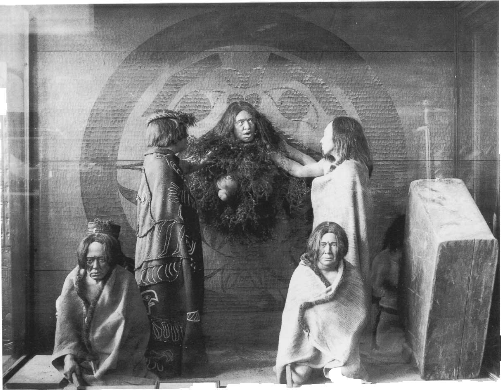
The Kwakiutls had gone back home by that time, so they couldn’t “pose” for the artists creating the mannequins. How did they “get it right”? In 1976 a collection of photos, missing for 75 years or so, surfaced that showed what helped them…
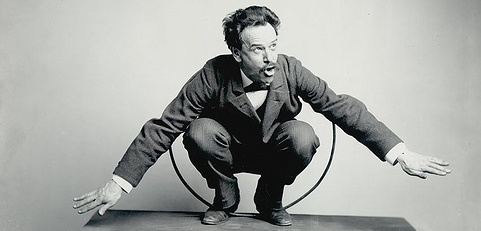
Yes, that is Boas himself, “posing” for the figure that will come out of a hole in the wall of the house. In fact, he evidently decided that his fancy suit was getting in the way of authenticity, and shed it to do another pose for the same mannequin.

And he went on to pose for other mannequins too, including the figures swathed in blankets in the eventual diorama.
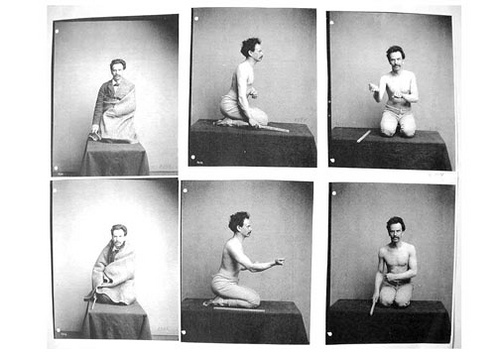
The live ceremony was repeated by other groups of Kwakiutls at other World’s Fairs in the years after the Chicago one, and other museums replicated the same scene shown in the Smithsonian. The Field Museum has its own, which I assume may be from the period right after the 1893 Fair.
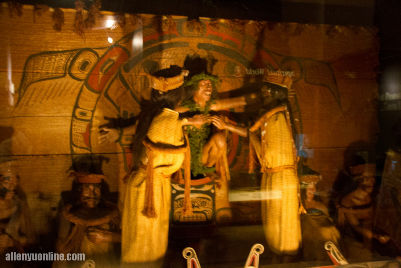
Other than the fact that Boas’s Kwakiutl exhibition happened in 1893, a year during the so-
The answer to that is that it introduces the topic of the Potlatch.
And what is a potlatch, you ask? Is it something like a potluck? Well, sort of.
I first remember seeing the word in my fourth grade Social Studies textbook, when we studied the customs of a variety of “Indian tribes” of North and South America. And I’m pretty sure I saw it again in the textbook for my Anthropology class in my university years. I also remember being fascinated by the story that went with the word.
A potlatch is a ceremonial festival that the Kwakiutl people have been doing for centuries…although it was theoretically legally “banned” from 1884-